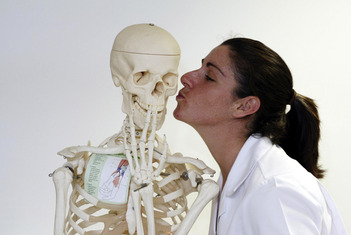3. Anatomy and physiology
Nick Southorn
Introduction – anatomy
It is universally accepted that anatomy is the subject to excel in as physiotherapists use anatomic knowledge for just about everything. Anatomy is the study of the structures of the human body, including bone, ligaments, muscles, organs, vessels and nerves. While it is often assumed that simply naming the structures is enough, it never is! As physiotherapists, you will need an exemplary knowledge of the functional anatomy of the human body, i.e. you will need to understand the interplay between the structures and how their shape affects their function. Once you have this knowledge, you can begin to use it therapeutically – like achieving mechanical advantage over a moment arm, utilizing anatomic features, such as the pores found in the lungs, to provide treatment and so on. Another use of anatomic knowledge comes in the form of diagnostics. The location of pain, the area of sensory loss, the limited range of movement, the palpation, the joint movement feeling, the auscultation, etc., etc., etc. You can never overestimate the importance of anatomic knowledge for the physiotherapy clinician. Ever. It is fortunate, then, that studying anatomy can be brilliant fun!
Visualizing anatomy
How you study anatomy depends on your learning style. It is helpful to make use of the university’s skeleton, or buy your own, and use string, sticky tac, sticky paper and bright marker pens and get stuck in. We learn more if we are having fun so get creative and cover that skeleton!
Using this will help you visualize the structures when you are assessing your patient. Another way, if you don’t have a skeleton to hand, is to use pens that are safe on human skin and color your friends in! See how creative you can get by artistically drawing the muscles and tendons or the lungs and their fields – don’t forget the abdomen and the organs in there. This can be great if you celebrate Halloween and you are heading off to a party.
A great way of remembering the structures in the hand: get a pair of gloves, those yellow washing-up ones if you are feeling well off or pinch a pair of disposables from university if you aren’t, and use a biro pen to write them on – you can do bones and ligaments on one hand and vessels and nerves on the other! I believe a swimming sock can do the same job for the feet. This idea has the advantage of aiding palpation skills too.
Don’t forget the peripheral nerves! From what spinal segment are the muscles and skin innervated (i.e. myotomes and dermatomes)? Where are important areas of nerve bundles? Are there any areas of nerve tissue that are at particular risk of damage? This area of anatomy is easy to forget but vital for understanding a variety of conditions that affect nervous function, from fractures to swollen tissue, as well as identifying at what spinal level a problem is likely to be.
Mnemonics and chants
OK, we all know what a mnemonic is – basically making certain things easier to learn by way of chant or using the first letter of each word to create either a word or sentence. For some reason in medicine, we like to make them as grotesque as possible, which makes writing about them in a book such as this one quite challenging.
They are marvellous, though, for things that can otherwise be confused; a good mnemonic or rhyme can soon straighten things out. So here are a few of the less outrageous ones that I remember. You may wish to challenge your tutor to tell you their method of remembering certain things! They come in useful for a range of topics but we’ll have a look at the anatomy ones here.
DEEP REFLEX NERVE ROOTS
One, two: buckle my shoe; three, four: kick the door; five, six: pick up the sticks; seven, eight: shut the gate.
| S 1 & 2 | Ankle jerk |
| L 3 & 4 | Knee jerk |
| C 5 & 6 | Biceps and brachioradialis |
| C 7 & 8 | Triceps |
CARPAL BONES (PROXIMAL ROW, THEN DISTAL ROW: MEDIAL TO LATERAL)
Some Lovers Try Positions That They Can’t Handle.
Scaphoid
Lunate
Triquetrum
Pisiform
Trapezium
Trapezoid
ROTATOR CUFF MUSCLES (AS THEY INSERT ONTO THE GREATER TUBERCLE OF THE HUMERUS, PROXIMAL TO DISTAL)
SITS
Supraspinatus
Infraspinatus
Teres minor
Subscapularis
BRONCHI – WHICH ONE IS MORE VERTICAL?
Inhale a bite; it goes down the right.
Small objects that are inhaled are more likely to occlude the right lung as the bronchus is more vertical.
HUMERAL FRACTURE AFFECTS:
ARM nerves (proximal to distal humerus)
Stay updated, free articles. Join our Telegram channel

Full access? Get Clinical Tree









